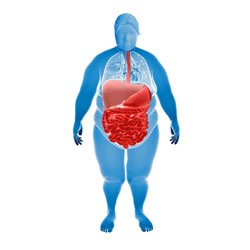
Understanding Inflammation's Link to Obesity, Diabetes, & Disease
Disease
This article provides introductory knowledge on the role of blood sugar and body fat on inflammation. Inflammation is the center-point of disease and the main contributor to obesity.

Understanding Inflammation's Link to Obesity, Diabetes, & Disease
Disease
This article provides introductory knowledge on the role of blood sugar and body fat on inflammation. Inflammation is the center-point of disease and the main contributor to obesity.
Wellness, from the standpoint of the body, is reduced inflammation.
Achieving physiologic balance is key to wellness. Physiologic balance (consider this the optimal environment for the body to function) involves the individual cell's ability to build, repair, detoxify, and perform their unique metabolic function. Physiologic balance is achieved through proper food, fitness, stress reduction disciplines, and nutrients. The combination of these results in peak metabolic performance... and a body through which dreams are realized!
When we address these needs of the body, it allows the body to do what it does best: build lean body mass, reduce body fat, and ultimately drive down inflammation which is the central process of disease. Wellness, from the standpoint of the body, is reduced inflammation.
Inflammation is the central meeting point of disease. You might consider inflammation to be disease and disease to be inflammation. Wellness, on the cellular level, is REDUCED INFLAMMATION.
What drives inflammation? Sugar!
Blood sugar and blood fat regulation are central to health and are tied together. For instance, diabetics have elevated blood sugars and blood fat levels and are therefore prone to developing diseases of the blood vessels (which can lead to heart attack) and obesity (due to resistance to insulin, which causes cells to remove blood sugar from the blood stream.)
Blood sugar (glucose and fructose) is also inflammatory to the body because excess sugar will bind to proteins in the blood stream creating "advanced glycation end products", or AGEs. AGEs are known to be associated with age related diseases and diabetes-related inflammatory conditions. Inflammatory conditions include asthma, arthritis, heart attack (due to atherosclerosis or blood vessel inflammation), and neuropathy.
In fact, cooking can promote disease through the production of AGEs. Cooking is chemistry: combing two or more elements in the presence of heat! So, super-heated foods and sugars (think french fries and funnel cakes) can create AGE products by causing sugars to bind to proteins. Be aware, you can actually ingest AGE products which may be the equivalent of eating inflammation! Essentially, you might be eating inflammation.
No nutritional product, diet, or herb can replace optimal eating habits. Supplements in and of themselves are helpful for providing missing nutrition but they are not a substitute for poor diet! Unfortunately, very few people understand what healthy eating means- so we encourage to be informed and apply what you should know! We provide Wellness Educational Resources on our website that also include a Wellness Blog and a Healthy Living Whole Foods Cookbook. There are many other sources of reliable information including PubMed and your healthcare providers.
Research shows that adiponectin decreases liver production of glucose, increases the uptake of blood sugar, stimulates fat breakdown and clearance in the body, protects bloods vessels, increases insulin sensitivity, and promotes weight loss.
So let's put it all together...
- Inflammation is central to disease.
- Blood sugar is associated with inflammation.
- Excess fat tissue promotes inflammation through reduced production of the protein hormone adiponectin.
- Nutrients and the african herb X promote physiologic balance and activity of adiponectin to reduce fat.
- Reducing fat will reduce inflammation.
- Reducing fat will reduce blood sugar levels, which also reduces inflammation.
- Educating yourself on clean eating, stress reduction, and optimal gastrointestinal health along with optimal nutritional supplementation can help you achieve wellness through balanced body systems!
- Obviously, this is a complex issue and represents the cutting edge in the science of wellness.

Dr. Jamie Wright, DO, MS, FACOOG, ABAARM has over 20 years of experience in the medical field. He graduated from Michigan State University / College of Osteopathic Medicine medical school in 2001. He is Double Board Certified with a Master's Degree in Metabolic and Nutritional Medicine.
Learn more about Jamie Wright.
-
 Discussion Forum
Questions or Feedback?
Discussion Forum
Questions or Feedback?Ask questions. Share your thoughts. Note that we cannot answer questions relating to specific medical conditions - please refer those to your qualified healthcare provider.
Post a new Comment or Reply to an existing one. Help for using the Discussion Forum.
 Discussion Forum Help
Discussion Forum Help
Comments are displayed in order of the last one posted so the most recent one is at the top and the oldest one at the bottom.
Replies within a Comment are displayed in reverse order with the oldest one at the top and the most recent one at the bottom.
Each post identifies
 who made the post and the
who made the post and the  date and time the post was made.
date and time the post was made.Mouse over the icons for tooltips that explain what they mean.

If you see this icon you can attach an Audio file to your post.

If you see this icon you can attach a Document file to your post.

If you see this icon you can attach an Image file to your post.

If you see this icon you can attach a Video file to your post.
You will see the
 Ban icon (Report Post as SPAM) immediately following the Timestamp of the post. Click this icon if you feel strongly that the content posted is not appropriate and should be reviewed by the Forum Moderator. You will be provided with a confirmation dialog to be sure you wish to submit this post for review. If submitted, the Forum Moderator will be notified to review the post and will determine what type of action to take.
Ban icon (Report Post as SPAM) immediately following the Timestamp of the post. Click this icon if you feel strongly that the content posted is not appropriate and should be reviewed by the Forum Moderator. You will be provided with a confirmation dialog to be sure you wish to submit this post for review. If submitted, the Forum Moderator will be notified to review the post and will determine what type of action to take.Click
 in the upper right corner of this Help modal or anywhere on the web page outside of the modal to exit Help.
in the upper right corner of this Help modal or anywhere on the web page outside of the modal to exit Help.
![]() Session Expired from Inactivity
Session Expired from Inactivity
Do you want to?
9618 Jefferson Highway, Suite D-191
Baton Rouge LA 70809-9636
(888) 424-0032 |
support@supplementrelief.com
* Disclaimer: This page is available exclusively for SupplementRelief.com clients. None of the information on this website is intended to replace your relationship with your healthcare provider(s). Nothing should be considered medical advice. The information, knowledge, and experience shared on this website are the opinions of SupplementRelief.com. This site and its content are intended to enhance your knowledge base as YOU MAKE YOUR OWN HEALTHCARE DECISIONS in partnership with your qualified health professional.
* These statements have not been evaluated by the Food and Drug Administration. These products and services are not intended to diagnose, treat, cure, or prevent disease.
* There is NO GUARANTEE OF SPECIFIC RESULTS for the products or services offered, and the RESULTS CAN VARY for each individual. Any results claimed by our customers are based on individual experiences that are unique and cannot be guaranteed.
FirstFitness Nutrition and NuMedica may be promoted and sold on the internet ONLY by Authorized Resellers who have been approved by and have registered their website domain with these companies. They strictly prohibit, and actively monitor, the UNAUTHORIZED SALE or RESALE of their products in ALL online public shopping portals including Amazon, eBay, and others and into other countries. All products purchased in SupplementRelief.com are for PERSONAL USE ONLY and CANNOT BE RESOLD to others. Please report violations of Reseller Policy directly to FirstFitness Nutrition at 800.621.4348 and to NuMedica at 800.869.8100.
The content and photographs on this website are copyrighted or Licensed Material and may not be downloaded for other than personal use. Republication, retransmission, reproduction, or any other use of the content or photographs is prohibited. ©2010-2024 SupplementRelief.com.
Are you sure you want to remove this item?
Warning: Undefined array key 0 in /home/supplementrelief/public_html/includes/core.php on line 6435

